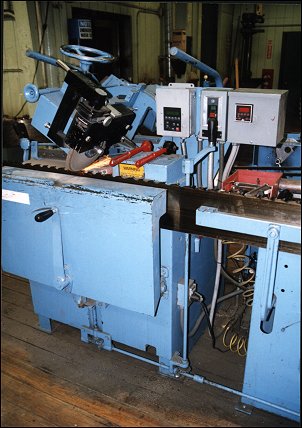Technology Enhances Armstrong No. 4 and 6 Band Saw Sharpeners
By Scott Emmert

Finer grit (80 grit and finer) saw grinding wheels often require a very light grind to prevent burning the saw. For that reason, many saw filers have replaced old conventional saw grinders with new full flood sharpeners equipped with variable speed motors such as the Armstrong PRO-Filer. Not all mills are ready to invest at that level. Even a sawmill on a tight budget can install frequency drives and micro groove flat belts on their sharpeners. This inexpensive technology is proving to be an investment with a fast pay back.
Frequency drives, or phase converters, have been around for years. Like all technology, frequency drives continue to improve in performance while becoming more affordable. Installing a frequency drive unit on the main gear head drive of the No. 4 or 6 sharpener produces many exciting options for improved performance. The main benefit is the ability to control the grind speed. When a saw is reswaged, the amount of stock removed is greater than for a saw that just needs sharpening only.
Similarly, Stellite tipped saws require substantial stock removal when freshly retipped. This heavy stock removal usually causes the corner of the grinding wheel to wear at normal grind speeds. A frequency drive allows the grind speed to be slowed on the first round of sharpening so the wheel cuts rather than breaking down under the extreme grind pressures. Many saw filers report improved grinding wheel life and a reduced chance of dubbing the point off the tooth. In fact, filers contend that a frequency drive coupled with a StrongArm II power clamp, is the only acceptable way to sharpen Stellite tipped band saws.
When shopping for frequency drives look for the following features:
- A "jog" button that will grant the operator the ability to advance short sections of saws a step at a time. This ability is of particular advantage when grinding saws with welded teeth. This greatly improves repair times and accuracy. The "jog" button allows the filer to turn out better saws in less time.
- A step frequency mode with inputs for limit switches allows grind zones to be established so that the grind speed can be varied throughout the tooth profile. The step frequency mode in conjunction with limit switches strategically placed around the cams of a No. 4 or 6 sharpener provide options that can only be found on machines costing thousands of dollars more. For example, a limit switch tripped by either the feed or head lift cam can signal the frequency drive to step down to a slower programmed speed in the gullet area. When the limit switch is released by the cam, it would resume the maximum speed setting. Another switch can do the same thing at the point of the tooth. This allows the use of finer grit grinding wheels without the risk of burn or it can simply improve the finish using standard grit wheels.
- A nice-to-have feature is an operator keypad that separates the programming keys from the operating keys. This eliminates the potential of accidentally changing "fixed" programming parameters. Frequency drives that use the same keys to program and operate often cause confusion. Eliminating the potential for an operator to accidentally end up in program mode when he thinks he is in run mode reduces a lot of frustrations.
A frequency drive big enough to run a No. 4 or No. 6 sharpener ranges in price from US$500 to $1000, depending on features.
In addition to frequency drives, the installation of a micro groove flat belt with sheaves on the grinding wheel spindle and motor can make a big difference in grind quality. Micro groove belts are thinner and wider than standard V-belts producing a greater contact area which reduces belt slippage. This allows the grinding wheel to remove stock more efficiently.
Bending V-belts around small diameter pulleys quickly develops deep cracks which in turn induces excessive vibration that can cause premature spindle bearing failure or possible burning of the saw when grinding. Due to the guards around the belt, this cracking often goes undetected. Micro groove flat belts are thinner and therefore don’t develop the deep cracks from bending stress like V-belts. Therefore, they produce very little vibration. Most filers report significant improvements in grind quality after installing this inexpensive technology.
The combination of frequency drives and micro groove flat belts greatly enhances the performance of a No. 4 or 6 band saw sharpener. These investments are definitely worth taking a look at. Belt conversion kits with the proper sheave diameters are available from Armstrong or your Armstrong Stocking Distributor/ Service Center.
A special thanks to Scott Emmert for contributing this article. Scott is an independent filing consultant and can be reached for training or troubleshooting at:
- Saw Performance Specialists
- 688 Birch Grove Drive
- Kalispell, MT 59901
- Phone: 406-756-SAWS (7297)
- Fax: 406-756-7497
Armstrong does not supply phase inverters. Check with your electrician or power transmission supplier for a recommendation.
| Previous Page | Table of Contents | Next Page |